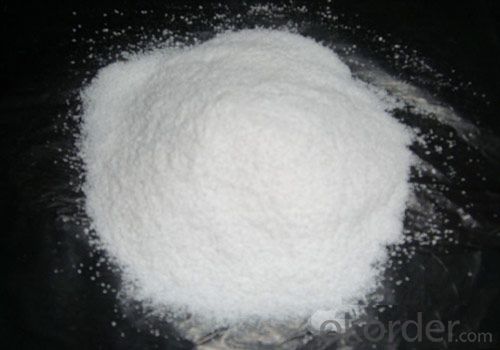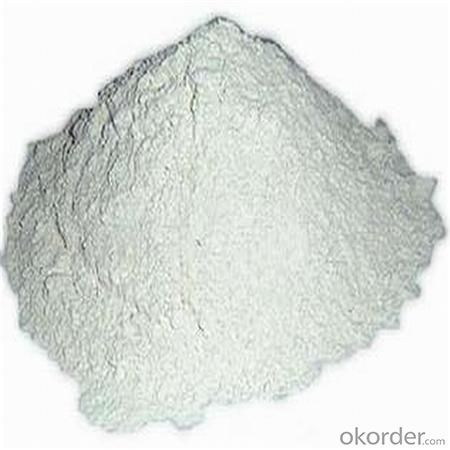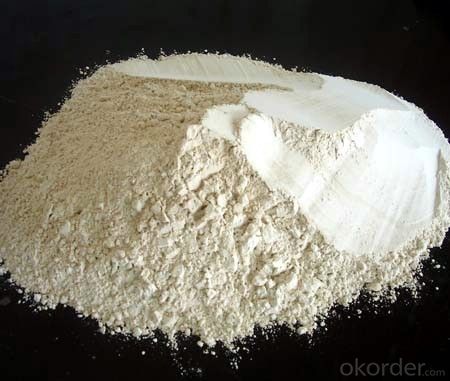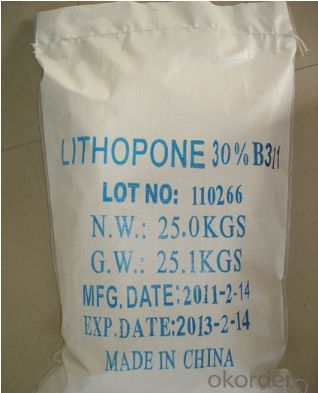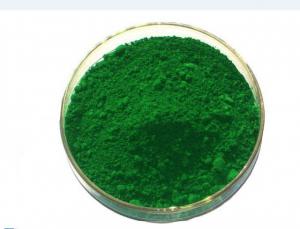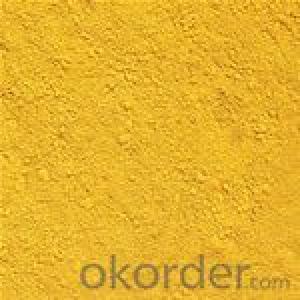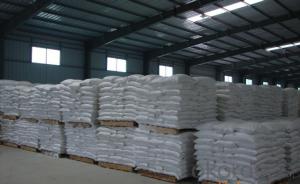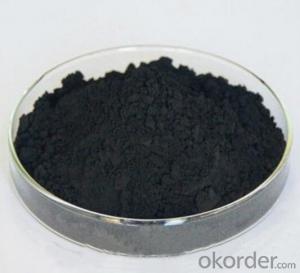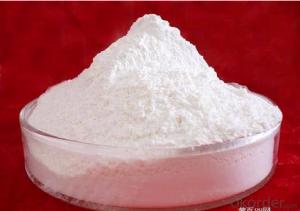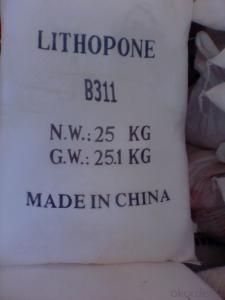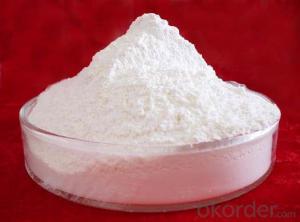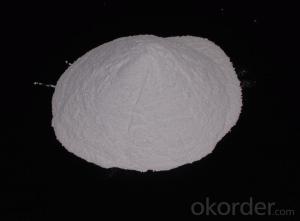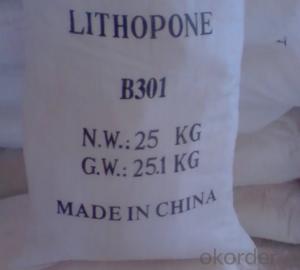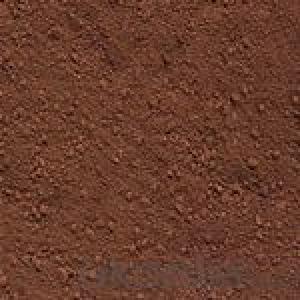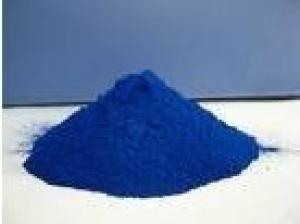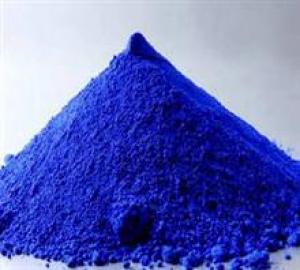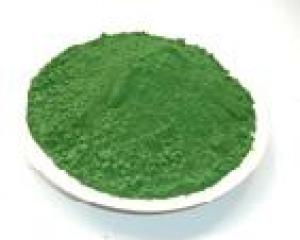Lithopone 28%-30% For Paint &Coating and plastic
- Loading Port:
- Tianjin
- Payment Terms:
- TT OR LC
- Min Order Qty:
- 20 m.t.
- Supply Capability:
- 2000 m.t./month
OKorder Service Pledge
OKorder Financial Service
You Might Also Like
Specifications
white powder pigment Lithopone 28%-30% for paint &coating
1 Timely delivery
2 High quality with best price
3 ISO&SGS qualifed
White Powder Pigment Lithopone 28%-30% For Paint &Coating
Characteristics:
High whiteness lithopone is a kind of new-style nontoxic, green, non- pollution lithopone, adopt unique nano technology production, coated by Silicon & Aluminum with characteristic resistance to acid and alkali, higher weathetability, nice optical performance, high whiteness and temperature resistant, strong hiding power and reducing power to prevent from yellow.
White Powder Pigment Lithopone 28%-30% For Paint &Coating
Applications:
Widely used in all paint coating papermaking, printing, ink, medium and low-grade paint coating can be instead of the alternative of titanium dioxide pigment.
White Powder Pigment Lithopone 28%-30% For Paint &Coating
Specification:
Test Project | Standard index value |
Antholeucin & BaSO4 % (m/m) ≥ | 99 |
ZnO% (m/m) ≤ | 0.3 |
105°C Volatile% (m/m) ≤ | 0.3 |
Water soluble % (m/m) ≤ | 0.3 |
Sieve residue (63μm mesh)% (m / m) ≤ | 0.1 |
Color (compare with standard sample) | Excel |
Alkali of the water extract | Neutral |
Oil absorption (g/100g) ≤ | 10 |
Color power consumption (with standard sample)% ≥ | 105 |
Conceal ability (contrast ratio) | Not Lower than 5% standard |
White Powder Pigment Lithopone 28%-30% For Paint &Coating
Notes:
Careful load and unload, be care not pollute or torn the package, avoid rain and insolation during transportation.
White Powder Pigment Lithopone 28%-30% For Paint &Coating
Store:
Store in ventilated and dry places, pile less than 20 tiers, keep away from goods that can effect the quality of the goods, against damp.
White Powder Pigment Lithopone 28%-30% For Paint &Coating
Package:
PP woven bag, paper bag net 25 kg, 500 kg, 1000 kg etc, also can be negotiated with the client.
White Powder Pigment Lithopone 28%-30% For Paint &Coating
packing & shipping terms:
Trade
| MOQ | 1 Ton | |
| Price | ||
| Port | Xingang Port, China | |
| Payment | L/C,T/T | |
| Supply Ability | 4000 Tons/Month | |
| Payment Terms | Sample | 3-5 Working Days |
| Lithopone | Within 15 Working Days | |
| Packaging | 25 or 50kg/woven bag or kraft paper or upon request | |
| Shipping | By Sea,Air | |
White Powder Pigment Lithopone 28%-30% For Paint &Coating
why choose us:
1. We are factory.we can guarantee production
2. High quality product
3. Considerate service
4. Efficient work and best quality
5. Products can be custom-made
6. Professional marketing team
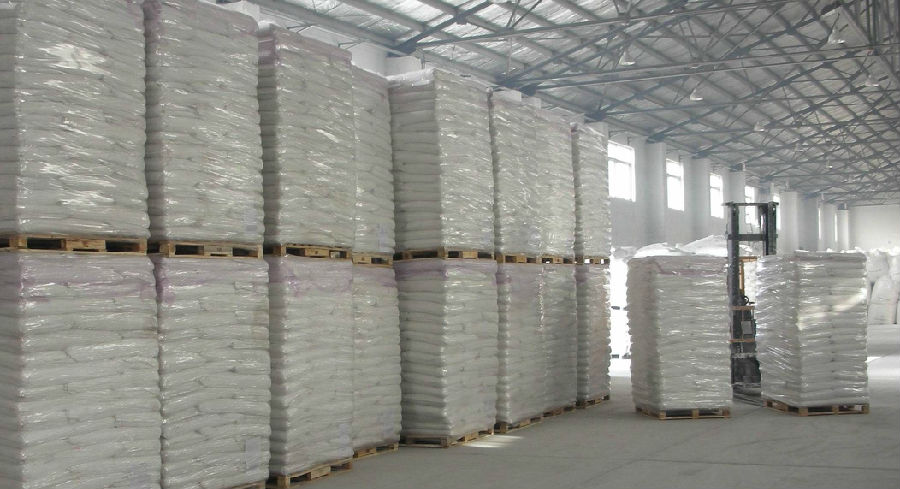
- Q: What is the role of pigment in photosynthesis photosynthesis ?
- Photosynthesis can't happen without the pigment chlorophyll (which is green and is why leaves and stuff are green). Chlorophyll is found in chloroplasts, an organelle in plant cells. Chlorophyll harnesses the sunlight's energy in order to split water (into hydrogen pairs and oxygen) so it can be used in the photosynthesis process (ie. in order to make glucose, the food source for plants). Hope this helps! :D
- Q: My wife went to the eye doctor to get new glasses (because she couldn't renew her driver's license with her glasses she had been using), and the doctor said that she wasquot;losing pigment" in both of her eyes. He said not to worry, but he wants her to make an appointment every 6 months, instead of just once a year.What does it (her losing pigment in her eyes) mean? Is it really nothing to worry about?(My wife doesn't seem worried, she hates going to doctor's but she trusts them when she goes to them; she doesn't ask questions-- she feels that if she needed to know something the doctor would tell her.)
- My okorder .
- Q: Know this ounds kinda obvious but just wanted to confirm, is there more pigment in the middle of the beetroot than on the edges?
- I've known it to be in the skin and thats from a cooking point of view.
- Q: Explain light activation of pigments (absorption of light by pigments)?
- A pigment is a substance that imparts color by absorbing some frequencies of visible light but not others. For instance, there are a lot of substances that absorb ultraviolet light into the visible spectrum, in other words they also absorb plain violet light. Since they absorb violet light but reflect back the rest of light, they appear yellow. Purple pigments, on the other hand, are quite rare because they absorb purple light (which has the highest energy of visible light) and reflect back everything else. When anything absorbs a photon of electromagnetic radiation (light, x-rays, ultraviolet, infrared, microwaves, gamma rays, radio waves), it is activated which means that it takes the energy of the photon and goes to an energy state that is higher by the same amount of energy that was in the photon. At the molecular level, energy is quantized, meaning its restricted to particular states. For instance, vibrational energy corresponds to infrared light: there are only certain ways, called modes, that a molecule can vibrate in, if it can't vibrate in an appropriate mode, it can't absorb the infrared radiation that corresponds to being promoted to that mode. That's why substances can be transparent. At the higher energy state, the substance might be able to participate in chemical reactions that it would not be able to participate in in a lower state. That's usually what is meant by light activation. So a pigment that absorbs visible or UV light might become activated and react with something or react in ways that it wouldn't be able to in the dark.
- Q: hi:]i need the right order to apply skin pigments...
- Pigments are usually packaged in a finely milled loose powder form. After cleansing , toning and moisturizing,let the moisturizer absorb in the skin. Apply the skin pigments using a large compact powder brush/kabuki brush in a circular motion on face neck, then apply a second layer in a downward motion. Then use Evian water Mister to set the pigment. For eye pigments, put a thin layer of skin pigment first, then apply the eye pigment using a oval shaped dome brush
- Q: explain how the pigments in colored objects such as clothes differ from plant pigments
- Green pigments absorb light in the red and blue parts of the spectrum and reflect the green back to our eyes. The major functional difference between chlorophyll and say jade green is that only the chlorophyll in living systems can transfer the absorbed light energy and the excited electron to another molecule, thus trapping it. In biology, pigment is any material resulting in color in plant or animal cells which is the result of selective absorption. Some biological material has so-called structural color, which is the result of selective reflection or iridescence, usually done with multilayer structures. Unlike structural color, pigment color is the same for all viewing angles. Nearly all types of cells, such as skin, eyes, fur and hair contain pigment. Butterfly wings typically contain structural color, although many of them contain pigment as well. Creatures that have deficient pigmentation are called albinos. In the coloring of paint, ink, plastic, fabric and other material, a pigment is a dry colorant, usually an insoluble powder. There are both natural and synthetic pigments, both organic and inorganic ones. Pigments work by selectively absorbing some parts of the visible spectrum (see light) whilst reflecting others. A distinction is usually made between a pigment, which is insoluble, and a dye, which is either a liquid, or is soluble. There is no well-defined dividing line between pigments and dyes, however, and some coloring agents are used as both pigments and dyes. In some cases, a pigment will be made by precipitating a soluble dye with a metallic salt. The resulting pigment is called a lake.
- Q: As in like makeup pigments??????
- Makeup pigments are kind of like skin pigments. They are the diffent shades. For example; everyone has a different coverup or foundation pigment.(color)
- Q: pigment: its color (to our eyes) what color of light it absorbsChl a Chl bCartenoidsany right answers would bbe greatly appreicated thanks soo muchhh
- pigment: .... reflected color to eyes .. what color of light it absorbs Chl a reflects green spectra between the blue and red absorption peaks. Some is absorbed at blue 450nm but most absorbed at red 680 - 700nm. Chl b reflects green spectra between the blue and red absorption peaks with a difference in which peak is stronger. Most is absorbed at blue 470 but also some at blue 430 and red 640 nm. Cartenoids reflect yellow, orange, or red and absorbs blue to blue-green light spectra. Xanthophyll absorbs well at 400-530 nm. Xanthophylls are a common sub class of the carotenoid pigment group. Beta-carotene absorbs most strongly between 400-500 nm.
- Q: is it the ink on regular printers?
- Some printers use only pigmented ink. Others use dye based and then some use a combination of both. Dye based ink is basically water based with a dye added to it. Pigmented ink has a solvent base with dye added. Pigment ink and dye based ink have both advantages and disadvantages. Dye based ink have better colors but pigment are more water and fade resistant. Dye based inks are therefore better for photos. I have a printer that has 4 dye based inks and a black pigment ink. Mine uses the dye based black and colours for pictures and the pigmented black is used for text. So the answer is yes. Pigmented ink is used in some regular printers.
- Q: So i'm writing up a lab report and i'm just a little confused on why scarlet, rosy, cinnabar and vermillion mutants contain the same kinds and amounts of pigments found in wild-type according to paper chromatography. Since they're mutants shouldn't it be different? I don't understand how i'm going to explain that they are mutants when it appears that they have the same phenotype as wild-type. Thank you so much for your help!
- Man pigments determine the colour of the eye. If the composition of pigments is same in all the flies,how can the colour in which their eyes look differ?isn't this a contradiction?i suspect the accuracy of The chromatography test because even a very very slight change in the amount of pigment can significantly change the colour. The phenotype is always different in mutants due to different genotype. in genotype is taken for granted if a change in phenotype is present. Wait just got over into a nice point. Sometimes even if the pigment composition being same different colours m8 be produced due to different allotropes or iro of the same pigment might have different colours!though allotropes(not isomers) have same composition but differ in,their post translational changes r different.since post translational changes r indirectly influenced by genes.this completely explains this case.
Send your message to us
Lithopone 28%-30% For Paint &Coating and plastic
- Loading Port:
- Tianjin
- Payment Terms:
- TT OR LC
- Min Order Qty:
- 20 m.t.
- Supply Capability:
- 2000 m.t./month
OKorder Service Pledge
OKorder Financial Service
Similar products
Hot products
Hot Searches
Related keywords




